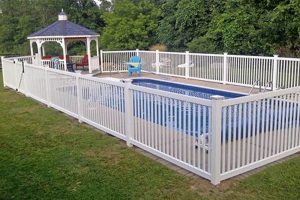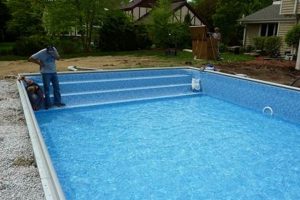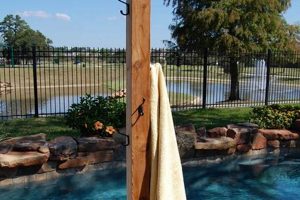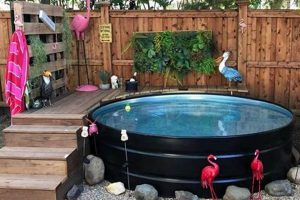A self-assembly pool package provides all the necessary components for constructing a recreational water feature. These packages typically include the pool liner, wall panels (if applicable), filtration system, pump, and plumbing. The purchaser undertakes the labor of assembling and installing these components, often following detailed instructions provided by the manufacturer.
Opting for a self-installation approach can offer significant cost savings compared to professional installation. It empowers individuals to customize certain aspects of the pool construction and gain a deeper understanding of its operational mechanics. Historically, the availability of such kits has broadened pool ownership to a wider range of homeowners, enabling them to create personalized backyard environments.
Subsequent discussions will delve into various aspects of these packages, covering material choices, the installation process, necessary tools, safety considerations, and the long-term maintenance requirements of such installations.
Installation Guidance
Successful assembly requires meticulous planning and adherence to the manufacturer’s instructions. Proper preparation is paramount to ensure a durable and safe recreational amenity.
Tip 1: Site Preparation is Crucial: Leveling the ground is essential. Uneven surfaces can compromise the structural integrity and liner lifespan. Use appropriate tools and measuring devices to guarantee a perfectly level base before commencing assembly.
Tip 2: Inventory Components: Before beginning, thoroughly inventory all components against the provided parts list. Discrepancies should be addressed with the supplier immediately to avoid project delays.
Tip 3: Adhere to Instructions: The manufacturer’s instructions are the definitive guide. Deviation from these instructions can void warranties and lead to structural problems. Consult diagrams and read steps carefully before proceeding.
Tip 4: Plumbing Connections: Ensure all plumbing connections are watertight. Use appropriate sealant and tighten fittings to the manufacturer’s specified torque. Pressure test the system before filling the structure completely.
Tip 5: Electrical Safety: All electrical connections must comply with local codes and regulations. Engage a qualified electrician to handle wiring for the pump and filtration system. Grounding is imperative.
Tip 6: Liner Installation: Carefully position the liner to avoid wrinkles and creases. Even distribution of the liner is crucial for a smooth, professional appearance and prevents stress points.
Tip 7: Backfilling Carefully: If the package requires backfilling, do so incrementally and evenly around the structure. Compaction of the backfill is necessary to provide support, but over-compaction can damage the structure.
Diligent execution of these guidelines contributes to a successful assembly, resulting in a safe and enjoyable recreational feature. Investing time in proper preparation and following instructions minimizes the potential for future complications.
The following sections will discuss long-term maintenance strategies and winterization procedures for maximizing the longevity of the installed structure.
1. Cost-Effectiveness
Cost-effectiveness represents a primary motivator for selecting a self-assembly pool solution. This approach fundamentally shifts labor costs from professional installers to the homeowner, potentially yielding substantial savings. The evaluation of cost-effectiveness, however, requires a comprehensive assessment beyond initial purchase price.
- Reduced Labor Expenses
The most immediate cost saving derives from eliminating professional installation fees, which often constitute a significant portion of the overall project expense. Homeowners undertaking the labor themselves directly avoid these charges. However, this assumes the homeowner possesses the necessary skills and time to complete the project successfully, avoiding costly mistakes that require professional intervention.
- Material Sourcing Flexibility
Certain self-installation packages allow for flexibility in sourcing supplementary materials, such as decking or landscaping elements. This autonomy enables the homeowner to seek competitive pricing and tailor choices to specific budgetary constraints, further optimizing overall project costs.
- Long-Term Maintenance Considerations
While initial savings may be attractive, long-term maintenance expenses must be considered. Some lower-priced kits may utilize less durable components, leading to increased maintenance and repair costs over time. A higher initial investment in a kit with robust, high-quality materials can potentially yield greater long-term cost-effectiveness by minimizing future expenditure.
- DIY Skill Level and Time Investment
Accurate assessment of one’s own capabilities is crucial. Errors resulting from inexperience can negate initial savings by necessitating professional repairs or even complete replacement of components. Additionally, the time investment required for self-installation can be considerable, potentially impacting other commitments and, indirectly, adding to the overall cost.
Ultimately, the cost-effectiveness of a do-it-yourself recreational water feature hinges on a balance of factors: initial purchase price, the homeowner’s skillset, material quality, and anticipated long-term maintenance demands. A thorough cost-benefit analysis, considering all these elements, is essential to determine the true economic viability of this approach.
2. Installation Complexity
The installation of a self-assembly pool inherently involves a degree of complexity that varies significantly depending on the kit design, the pool’s size, and site conditions. Understanding and realistically assessing this complexity is paramount to a successful outcome. Improperly managed assembly can lead to structural issues, leaks, and compromised safety, ultimately negating any potential cost savings.
- Foundation Preparation and Leveling
Achieving a perfectly level base is critical. This often requires significant excavation and the use of specialized leveling equipment, such as laser levels or transit levels. Uneven ground can cause structural stress, liner damage, and an aesthetically unappealing finished product. Inadequate preparation can lead to settling and shifting over time, requiring costly repairs.
- Plumbing System Integration
Connecting the filtration system, pump, and drainage requires precise plumbing skills. Incorrectly sealed connections can result in leaks, reduced water quality, and equipment malfunction. Understanding pipe sizing, fitting types, and appropriate sealant applications is crucial for a leak-free and efficient system.
- Electrical Component Installation
Wiring the pump, filter, and any lighting requires adherence to local electrical codes and safe practices. Improper wiring can create a significant electrocution hazard and damage equipment. It is strongly recommended that a qualified electrician perform all electrical work associated with the assembly.
- Structural Assembly and Liner Placement
Assembling the pool walls (if applicable) requires careful alignment and secure fastening. Improperly aligned walls can compromise structural integrity. Liner placement demands precision to avoid wrinkles and creases, which can weaken the material and detract from the aesthetic appearance. Stretching the liner too tightly or unevenly can lead to premature failure.
The level of difficulty associated with each of these facets influences the overall success. While some homeowners may possess the skills and experience to manage the entire process, others may find it necessary to enlist professional assistance for specific aspects. A realistic assessment of one’s capabilities and a willingness to seek expert help when needed are essential components of a successful self-installation project.
3. Material Durability
The longevity and overall value proposition of a self-assembled pool are inextricably linked to the durability of its constituent materials. The pool liner, wall panels (if present), plumbing components, and filtration system elements are all subject to constant exposure to water, chemicals, and environmental factors. The inherent resistance of these materials to degradation directly impacts the lifespan of the entire installation. For example, a liner constructed from a low-grade vinyl is demonstrably more susceptible to punctures, tears, and UV damage than a liner fabricated from a thicker, reinforced material. Similarly, plumbing components made from inferior plastics can become brittle and prone to cracking, leading to leaks and potentially requiring extensive repairs. The initial cost savings associated with a kit utilizing less robust materials are often offset by increased maintenance expenses and a shorter overall lifespan.
The selection of materials resistant to chemical degradation is also of paramount importance. Pool water requires chemical treatment to maintain sanitation and prevent algae growth. Constant exposure to chlorine, bromine, or other sanitizing agents can accelerate the breakdown of certain materials. Liners, seals, and fittings specifically designed to withstand these chemicals are essential for preventing premature failure. Furthermore, the structural integrity of the pool walls (in above-ground models) depends on the corrosion resistance of the metal or polymer used in their construction. Rusting or weakening of these walls can compromise the entire structure, posing a significant safety hazard. Examples of durable materials frequently employed include high-density polyethylene for pool walls, reinforced PVC for liners, and schedule 40 PVC for plumbing.
In conclusion, material durability is not merely a desirable feature but a fundamental requirement for a successful self-installed recreational water amenity. Understanding the material properties and their susceptibility to environmental and chemical stressors allows informed purchasing decisions and proactively mitigates potential long-term costs and safety concerns. Prioritizing the use of robust and chemically resistant materials is a crucial investment in the longevity and enjoyment of the finished product.
4. Warranty Coverage
Warranty coverage serves as a critical risk mitigation factor for individuals undertaking self-installation of recreational water amenities. Such coverage provides a degree of financial protection against defects in materials or workmanship inherent to the pool kit components. It is not a blanket guarantee against all potential issues but rather a safeguard against manufacturing flaws or premature failure of specific parts under normal operating conditions. The absence of adequate warranty coverage exposes the installer to the full financial burden of replacing defective components, potentially negating any initial cost savings realized through self-installation. Real-world examples demonstrate instances where substandard welding on pool wall panels resulted in structural failure shortly after installation. With valid warranty coverage, the manufacturer would typically provide replacement panels, thus avoiding significant out-of-pocket expenses for the homeowner. Without such coverage, the homeowner would bear the full cost of remediation.
The scope and terms of warranty coverage vary considerably among manufacturers. It is crucial to scrutinize the warranty documentation before purchase, paying particular attention to the specific components covered, the duration of the coverage, and any limitations or exclusions that may apply. For example, some warranties may cover the pool liner for a specified period against manufacturing defects but exclude damage caused by improper installation or chemical imbalances in the water. Other warranties may require professional installation of certain components, such as the electrical system, to remain valid. A thorough understanding of these conditions is essential to ensure that the warranty provides meaningful protection.
In summary, warranty coverage represents a vital component of a “diy swimming pool kit,” offering a degree of financial security against manufacturing defects. However, the effectiveness of this protection hinges on a careful assessment of the warranty’s scope, terms, and conditions. Neglecting to thoroughly review and understand the warranty documentation can leave the installer vulnerable to unforeseen expenses and undermine the overall value proposition of the self-installation approach. The selection of a kit with comprehensive warranty coverage, coupled with adherence to proper installation practices, is paramount to mitigating risk and maximizing the long-term benefits of a self-installed recreational water feature.
5. Maintenance Demands
The acquisition of a self-assembled recreational water feature invariably precipitates ongoing maintenance responsibilities. The extent and nature of these demands are directly correlated with the initial construction quality, the selected filtration system, and the frequency of usage. Neglecting maintenance can result in unsanitary conditions, equipment malfunction, structural degradation, and ultimately, a reduction in the usable lifespan of the amenity. A self-installation approach, while potentially cost-effective initially, places the onus of consistent upkeep squarely on the homeowner. For example, a poorly chosen filtration system may necessitate more frequent cleaning and chemical adjustments, increasing both the time and expense associated with maintaining water quality. The consistent removal of debris, regulation of chemical balance, and periodic inspection of equipment are essential components of responsible ownership.
Specific maintenance protocols often include regular vacuuming of the pool floor, skimming the surface to remove leaves and insects, backwashing the filter, and testing the water’s pH and alkalinity levels. The consistent regulation of water chemistry is crucial for preventing algae blooms, corrosion of equipment, and skin irritation. Moreover, seasonal variations necessitate adjustments to maintenance routines. Winterization procedures, for instance, involve draining the pool (partially or fully, depending on the climate), covering it to protect against debris accumulation, and adding antifreeze to plumbing lines to prevent freezing and subsequent damage. Conversely, the spring start-up requires a thorough cleaning, equipment inspection, and rebalancing of the water chemistry. The selection of a “diy swimming pool kit” should therefore incorporate careful consideration of these recurring maintenance requirements.
In summary, the relationship between the installation and subsequent upkeep is inextricable. Understanding and proactively addressing these demands is crucial for maximizing the enjoyment, safety, and longevity of the aquatic installation. Proper maintenance is not an optional addendum but an integral element of responsible ownership, directly influencing the long-term value and viability of the initial investment. Potential purchasers should carefully evaluate their capacity to commit to these ongoing responsibilities before undertaking a self-installation project.
6. Safety Regulations
Strict adherence to established safety regulations is an indispensable component of any self-installation endeavor involving recreational water features. The implementation of a “diy swimming pool kit” inherently transfers the responsibility for ensuring compliance from professional installers to the homeowner. This necessitates a comprehensive understanding of local, regional, and national codes pertaining to pool construction, electrical safety, fencing requirements, and water quality standards. Non-compliance can result in substantial fines, legal liabilities, and, most importantly, an elevated risk of accidents, injuries, or even fatalities. For instance, inadequate fencing around a pool can lead to unsupervised access by children, significantly increasing the likelihood of drowning. Similarly, improper grounding of electrical equipment can create a severe electrocution hazard.
The practical significance of understanding and adhering to these regulations extends beyond mere legal compliance. Properly implemented safety measures, such as compliant fencing, self-closing and self-latching gates, anti-entrapment drain covers, and ground fault circuit interrupters (GFCIs) for electrical circuits, actively mitigate potential risks and create a safer environment for users. A real-world example is the implementation of the Virginia Graeme Baker Pool and Spa Safety Act, which mandates specific safety standards for drain covers to prevent suction entrapment. Prior to this legislation, numerous incidents occurred involving individuals, particularly children, becoming entrapped by pool drains, resulting in serious injuries and fatalities. Adherence to this regulation, therefore, directly contributes to the reduction of such incidents. Moreover, proper signage indicating pool rules and depths is crucial for informing users of potential hazards and promoting responsible behavior.
In conclusion, “Safety Regulations” are not merely ancillary considerations but rather integral to the responsible and ethical implementation of a “diy swimming pool kit”. The potential consequences of non-compliance extend far beyond financial penalties, encompassing the risk of serious harm to individuals. Homeowners undertaking self-installation projects must prioritize the thorough understanding and diligent application of all applicable safety regulations to ensure the creation of a safe and enjoyable recreational environment. This proactive approach is essential for safeguarding lives and mitigating potential liabilities, ultimately contributing to the long-term viability and value of the investment.
Frequently Asked Questions
The following addresses common inquiries regarding self-installation.
Question 1: What prior experience is necessary to assemble this product?
While prior construction experience can be beneficial, it is not strictly required. The ability to accurately follow detailed instructions, use basic hand tools, and dedicate sufficient time are more crucial determinants of success. Familiarity with plumbing and electrical systems is advantageous but specialized expertise may be required for certain connections.
Question 2: Are specific tools required for assembly that are not typically found in a standard household toolkit?
Typically, specific tools beyond a standard household set are often required. These may include a transit level or laser level for precise leveling of the ground, a torque wrench for tightening fittings to specified values, and specialized plumbing tools for making watertight connections. A complete list of required tools is typically provided by the manufacturer.
Question 3: What are the potential ramifications of failing to properly level the ground before beginning the structure assembly?
Inadequate leveling can lead to structural instability, uneven water depth, compromised liner integrity, and premature failure of the structure. Uneven weight distribution can stress the pool walls and cause them to buckle or collapse. Repairing these issues post-installation is significantly more complex and costly than proper initial preparation.
Question 4: How does the warranty coverage apply when the product is self-installed versus professionally installed?
Warranty coverage can differ between self-installed and professionally installed projects. Self-installation may void portions of the warranty related to workmanship. The manufacturer typically warrants against defects in materials but not against errors made during the assembly process. Professional installation often provides broader coverage, including protection against installation errors.
Question 5: What steps must be taken to ensure electrical safety during and after assembly?
Electrical safety demands strict adherence to local electrical codes. Engaging a licensed electrician to handle all wiring is strongly recommended. Ground fault circuit interrupters (GFCIs) are essential for all electrical circuits associated with the water feature. Regular inspection of wiring and equipment is necessary to identify and address potential hazards.
Question 6: What are the key considerations for winterizing the structure in climates subject to freezing temperatures?
Proper winterization involves partially or fully draining the structure, disconnecting and storing the pump and filter, plugging plumbing lines, and covering the water feature. Anti-freeze specifically designed for pools must be added to plumbing lines to prevent freezing and bursting. Failure to adequately winterize can result in significant damage to the liner, plumbing, and equipment.
Proper planning and execution are key to successful self-installation.
The following section will explore advanced topics relating to these amenities.
Conclusion
This exploration of the “diy swimming pool kit” has illuminated its multifaceted nature, extending beyond simple cost savings to encompass considerations of skill, time investment, material quality, safety regulations, and long-term maintenance. A superficial evaluation focusing solely on the initial purchase price can obscure the true complexities inherent in a self-installation project. Success hinges on a comprehensive understanding of the inherent challenges and a realistic assessment of one’s capacity to address them effectively.
Ultimately, the decision to undertake a self-installation project requires careful deliberation. While the potential for creating a personalized recreational water amenity is undeniable, prospective installers must approach the endeavor with diligence, prioritizing safety, quality, and adherence to established guidelines. Only through informed planning and meticulous execution can the benefits of a “diy swimming pool kit” be fully realized, creating a valuable addition to the home environment.







